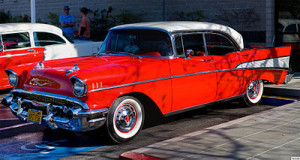Fifty-eight years ago today my parents were married in St. John the Baptist Church in downtown New Orleans. My mom was 19; my dad was 22. I – their eldest child – was born just over nine months later.
in downtown New Orleans. My mom was 19; my dad was 22. I – their eldest child – was born just over nine months later.
While I obviously have no memories of my parents’ wedding, I have in my head images of it because much of it was captured by an amateur photographer on 8mm film – a reel of silent, but color, film that I saw often as a boy whenever Dad projected it onto a screen that he’d set up in the den of our home. (I’m increasingly astonished that two people who married so young managed to remain together, happily, for 50 years, until my mom died in March 2008.)
Back then, the most popular new passenger car on America’s roads was (I believe) the ’57 Chevy Bel Air.  The base retail price for the Sport Sedan was $2,424 (in 1957 dollars) – a price that did not include air-conditioning, power steering, power brakes, power windows, seat belts, and air-bags (not to mention familiar devices in today’s cars such as GPS navigation, keyless entry, a tilt steering wheel, and windshield wipers with intermittent settings). I do believe, though, that an AM radio – with a single speaker – was standard equipment. (The buyer could have gotten an additional, rear speaker for an extra charge.) The average hourly wage in America for workers in manufacturing in 1957 was $1.98 (also in 1957 dollars). So in the year of my parents’ wedding, the typical worker in America had to toil about 1,224 hours – or about 30.5 weeks – to earn enough money to buy a new, base-model Chevy Bel Air Sport Sedan.
The base retail price for the Sport Sedan was $2,424 (in 1957 dollars) – a price that did not include air-conditioning, power steering, power brakes, power windows, seat belts, and air-bags (not to mention familiar devices in today’s cars such as GPS navigation, keyless entry, a tilt steering wheel, and windshield wipers with intermittent settings). I do believe, though, that an AM radio – with a single speaker – was standard equipment. (The buyer could have gotten an additional, rear speaker for an extra charge.) The average hourly wage in America for workers in manufacturing in 1957 was $1.98 (also in 1957 dollars). So in the year of my parents’ wedding, the typical worker in America had to toil about 1,224 hours – or about 30.5 weeks – to earn enough money to buy a new, base-model Chevy Bel Air Sport Sedan.
Today’s most popular passenger car in America is the Toyota Camry, the base model of which sells for $22,970 plus an $825 delivery fee – so, in total, $23,795. (I need not here remind readers what is standard equipment in such a car compare to what was standard equipment in a ’57 Chevy.) The typical, non-supervisory worker in America today (October 2015) earns $21.18 per hour – meaning that today’s typical worker in America must work 1,123 hours – or 28 weeks – to earn enough income to buy a new, base-model Toyota Camry. Compared to 1957, two-and-a-half weeks less work is required today of an ordinary American worker to buy a popular new car – a popular new car that is nearly indescribably superior to a ’57 Chevy.
A gallon of milk in 1957 cost, in 1957 dollars, $1.00 – or about a half-hour of work time of the typical American worker. Today a gallon of milk, in 2015 dollars, is about $3.50 – or about 10 minutes of work time of the typical American worker today. A gallon of gasoline in 1957 – lead and all – cost about $0.30 (or 9 minutes of work time for the typical American worker in that long-ago year). I just filled-up my car’s tank with 87-octane, lead-free gasoline and paid (in northern Virginia) $2.09 per gallon – an amount of money that the typical American worker today earns in about 6 minutes.
Alas, the work-time cost of first-class postage from the U.S. Postal Service is indeed higher today – by about 50 percent! – than it was in 1957. In 1957 the price of a first-class postage stamp was $0.03; today it’s $0.49. So while the typical American worker in 1957 had to work just under one minute to earn enough income to mail a letter or wedding invitation, the typical American worker today must toil close to a minute and a half to earn enough income to mail a first-class letter.
(I got the above 1957 prices here.)
Three years ago I looked in some detail at the offerings and prices in a Sears catalog from 1956 and discovered that the cost of living for the typical American (measured in work time) was much higher then than it is today. See also here, here, here, and here.
Except for when they must purchase government ‘services,’ young couples starting life today have a far easier time of it, overall, than did my parents in 1957.



